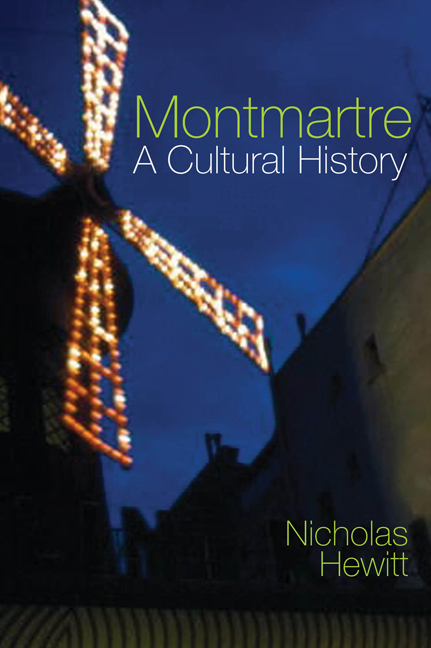Book contents
- Frontmatter
- Dedication
- Contents
- List of Illustrations
- Acknowledgements
- Map
- Introduction
- 1 ‘Montons à la Barrière’
- 2 The Artistic Cabarets
- 3 Music Halls and Mass Culture
- 4 Theatre and the Avant-Garde
- 5 The Bateau-Lavoir and the Lapin Agile
- 6 Wartime and the Années Folles
- 7 The Place of Memory
- 8 The Ecole de Montmartre
- 9 The Occupation: Céline and Aymé
- Epilogue: Montmartre on Film
- Bibliography
- Index
- Plate section
3 - Music Halls and Mass Culture
- Frontmatter
- Dedication
- Contents
- List of Illustrations
- Acknowledgements
- Map
- Introduction
- 1 ‘Montons à la Barrière’
- 2 The Artistic Cabarets
- 3 Music Halls and Mass Culture
- 4 Theatre and the Avant-Garde
- 5 The Bateau-Lavoir and the Lapin Agile
- 6 Wartime and the Années Folles
- 7 The Place of Memory
- 8 The Ecole de Montmartre
- 9 The Occupation: Céline and Aymé
- Epilogue: Montmartre on Film
- Bibliography
- Index
- Plate section
Summary
Essentially, the lifespan of the artistic cabarets was remarkably short, lasting little more than twenty years from 1881 to the turn of the century. Popular and mass entertainment in Montmartre proved much more durable, predating the cabarets, running alongside them and eventually outlasting them. At the same time, music hall was able to expropriate some of the major features of cabaret entertainment and assimilate many of the major stars. It is necessary initially, however, to distinguish between two forms of this popular entertainment, which intermingle but nevertheless present different characteristics. In Le Piéton de Paris, Léon-Paul Fargue recalls that Willette frequently pointed out to journalists that ‘like Jesus between the two thieves, the Sacré-Coeur stood flanked by the Moulin de la Galette and the Moulin Rouge’. In fact, the two windmills represent two separate traditions of popular entertainment: the dance halls, or bals, of which the most famous examples are the Moulin de la Galette itself and the Elysée Montmartre, and the music halls, represented by the Moulin Rouge, Folies Bergère and Casino de Paris. Both traditions inevitably intermingle, but together they contribute massively to the establishment of Montmartre as a Parisian pleasure centre and, as an important subject for painting, to its artistic activity.
The Dance Halls
According to Jean Barreyre, ‘in 1810, Montmartre had sixteen bals régis, or authorised dance halls, in addition to a large number of bals guinguettes (from the name of the founder of a cabaret Pierre Guinguet) run by café owners and dependant on the availability of musicians. The bals régis opened most often on Sundays, Mondays and holidays’. The most famous of these official dance halls was, as we have seen in Chapter One, the Moulin de la Galette on the Rue Tholozé, which evolved from a working windmill that also dispensed wine and – its speciality – home-made cake (the galette which gave the establishment its name), to a fully fledged dance hall, the Bal Debray, with the collapse of the Montmartre flour mills in the 1830s. Very rapidly, the Moulin de la Galette attracted a less localised clientele, including artists, peasant girls from the outlying suburbs, maidservants and other female workers.
- Type
- Chapter
- Information
- MontmartreA Cultural History, pp. 64 - 85Publisher: Liverpool University PressPrint publication year: 2017



